Oroville Dam Levels.
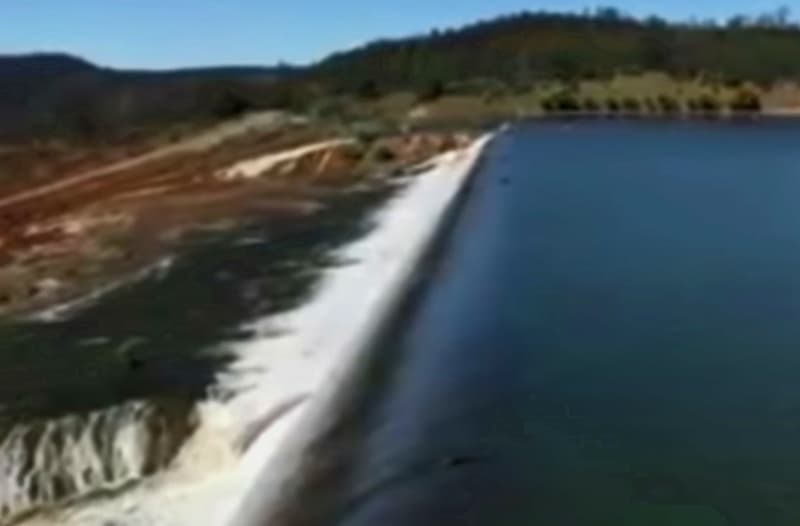
Below in the article, I talk about the risks of starting the year off with over 700 feet of water in Lake Oroville.
In the original article, I mentioned the Feast or Famine type of weather patterns that are associated with a grand solar minimum, which we will be in for many more years to come, probably peaking around 2030.
This has been the reason for the bizarre weather patterns around the world. In this 2020 season, the Oroville area was lucky enough to experience the Famine rainfall weather pattern. Unlike the 2019 season, where the Oroville Dam nearly overflowed again.
I believe that it’s gambling, during these days of erratic and unpredictable weather patterns, to start off the rainy season with over 700 feet of water in Oroville’s reservoir.
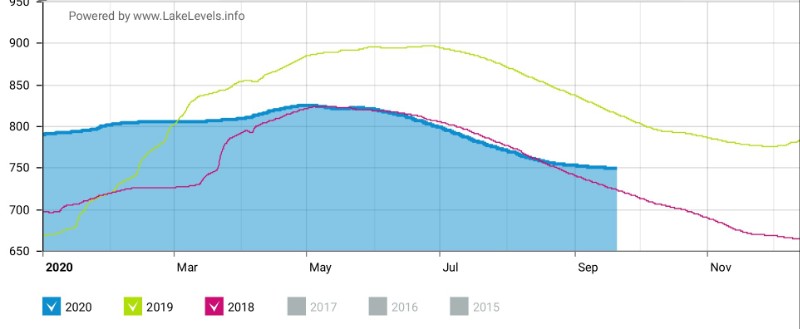
The Original Article.
This will just be a short article, on a topic that I believe Californians should be paying attention to. Both Shasta dam, and the Oroville Dam are starting the year off with higher water levels than usual.
Now if you’ve read some of my other blogs, you’ve probably noticed that I’ve talked about the grand solar minimum in a few of them.
There’s a good reason for this, this may be one of the most important events that we’ll experience in our lifetime, dramatically altering weather patterns for the next few decades.
The best way to describe how the weather acts in a grand solar minimum is, feast or famine. The only thing that can be predicted is, that we’re bound to see some crazy weather.
This will cause extreme weather phenomenon is certain areas, like rainfall and snowfall events that we have never seen. When this happens, dams and rivers could be in more danger of overflowing.
So for the Shasta and Oroville Dams, will it be Feast or Famine through these grand solar minimum years? We’ll have to watch this for years to come, especially near the year 2030 when the minimum is predicted to peak.
Record Breaking Floods and Snowfall.
Worldwide we’re already seeing record breaking floods and snowfall, causing massive crop losses in the United States and other countries. The effects this solar minimum are already in motion.
What can we expect from a grand solar minimum? It will effect areas differently. Some may get drought, while other areas get a deluge of rainfall. The cosmic rays increase with low solar activity because our Earth’s magnetic shields become weak, the jet streams change, and the weather then becomes much more extreme.
So how does this apply to the Oroville Dam? Well it seems that the Northern California is one of those areas that experiences an increase in rainfall and snow, during the solar minimums.
the Oroville Dam Overflowed.
You might remember back when Oroville Dam overflowed and caused the huge evacuation of Oroville and seriously eroded the base of the dam, well that year, they began the year with a higher than usual water level, this was very similar to the beginning of 2020 level.
Notice that the water level in 2020 is even starting off higher than 2017, when the dam overflowed, (the orange line). Also notice that there was no where near the same amount of water level rise in the year of the overflow, as there was in 2019 (the green line), keep in mind that the flood level of Oroville Dam is 901 feet. (The top of the orange line).
Now imagine the same amount of water level increase as the 2019 year, (the green line) happening from where the water level is beginning the year in 2020, (the blue line).
Oroville Dam Levels.
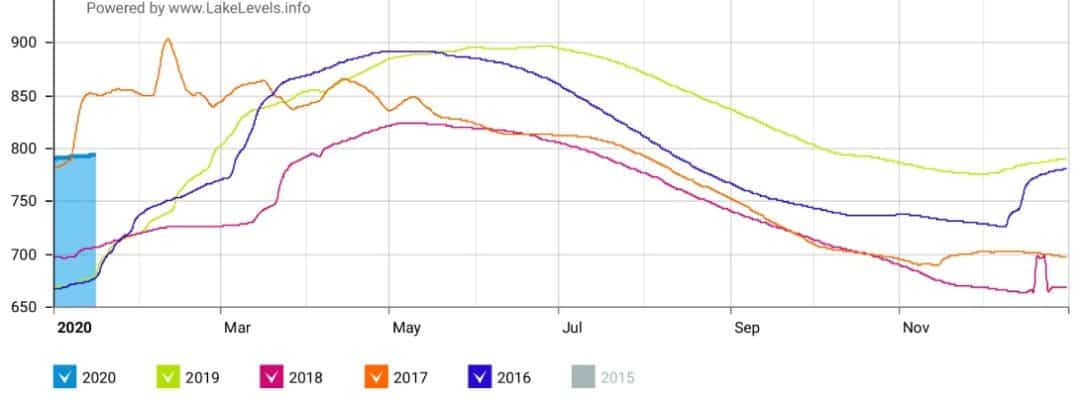
Why I’m concerned with this is, in 2019 Northern California had above average rainfall, and if you look at the graph below, and charted the same amount of water level increase as 2019, to where 2020 is starting from, the line would show the water level as being about a hundred feet over the top of the dam.
Oroville Dam’s New Spillway.
If the water begins topping the dam, even if the dam is capable of surviving this with their new spillway, the amount of water going down the river is no longer able to be regulated by the dam. The Feather River and the Sacramento River would then be at the mercy of whatever Mother Nature then throws their way.
Sacramento River and Shasta & Oroville Dam.
What makes this even more concerning is, Shasta Dam is also beginning the year at a higher level than normal. So my question is, if we get an above average rainfall year, will the Sacramento River be able to handle heavy releases, or even uncontrollable overflows from these two major reservoirs?
Shasta Dam Levels.
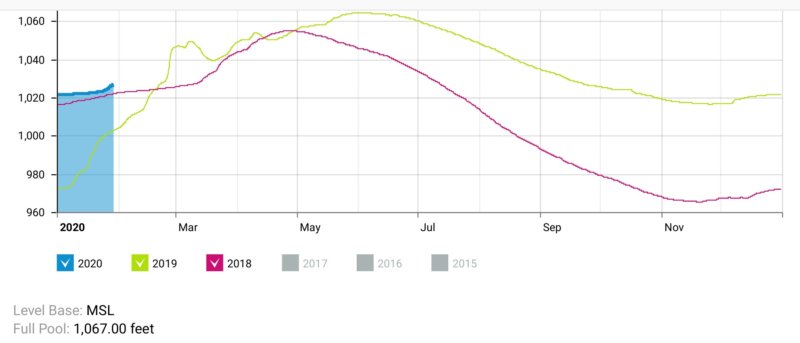
Look at this chart, and imagine if we get as much rain as 2019. (The green line). Keep in mind that that the top of that green line is the dam nearly completely full at 1,067 feet. Now if 2020 (the blue line), rises the same amount as 2019, well you can see the concern.
So now back to why the grand solar minimum can play such a large role in this. Since the low solar activity seems to be increasing rainfall Northern California, we need to take to look at record low solar activity we’ve had in 2019. This judged by the amount of sunspot free days during the year.
California Rainfall in a Grand Solar Minimum.
2019 had an incredible 273 sunspot free days, this is the fourth highest amount in any year since 1849.
The year prior in 2018, was also a record year, see the chart below. Notice the increase in 2019. Seems as if the next grand solar minimum has begun.
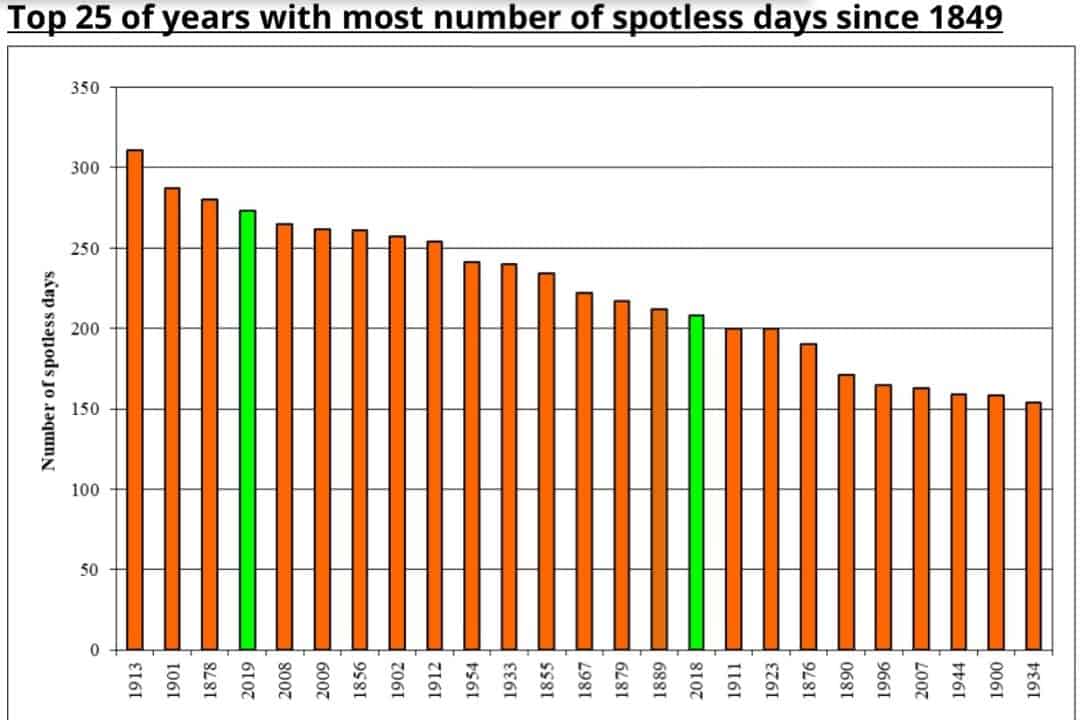
Many of the researchers are saying these trends are very comparable to the way the Maunder Minimum started, this was one of the most intense grand solar minimums in our recorded history, and was responsible for what we know as the Little Ice Age. So the winter of 2020 may even surpass all the crazy weather events that have happened over the last few years.
Isn’t Flood Control the Top Priority?
The question here remains, in an unpredictable solar minimum weather scenario, should the California Department of Water Resources gamble, and start the year off with nearly 100 more feet of water then usual. Shouldn’t flood control be their first concern?
To sum this all up, if it turns out that 2020 has more rainfall than 2019, and both Shasta Dam and Oroville Dam are at higher levels than normal at the beginning of the year, they may have to release large amounts of water as they reach capacity, or worse yet, if the Oroville Dam overflows. How will the Feather River and the Sacramento River handle this?
I will be updating and adding to this as 2020 passes, and we see how this plays out. So if you’d like to come back in the future to check out the updates updates. With any luck, the concerns I’ve expressed here will not come to pass.
This original article was published in January of 2020. Updates will follow at the top, as time goes on, keeping an eye on the dam levels at the beginning of the season, and the yearly rainfall patterns.
